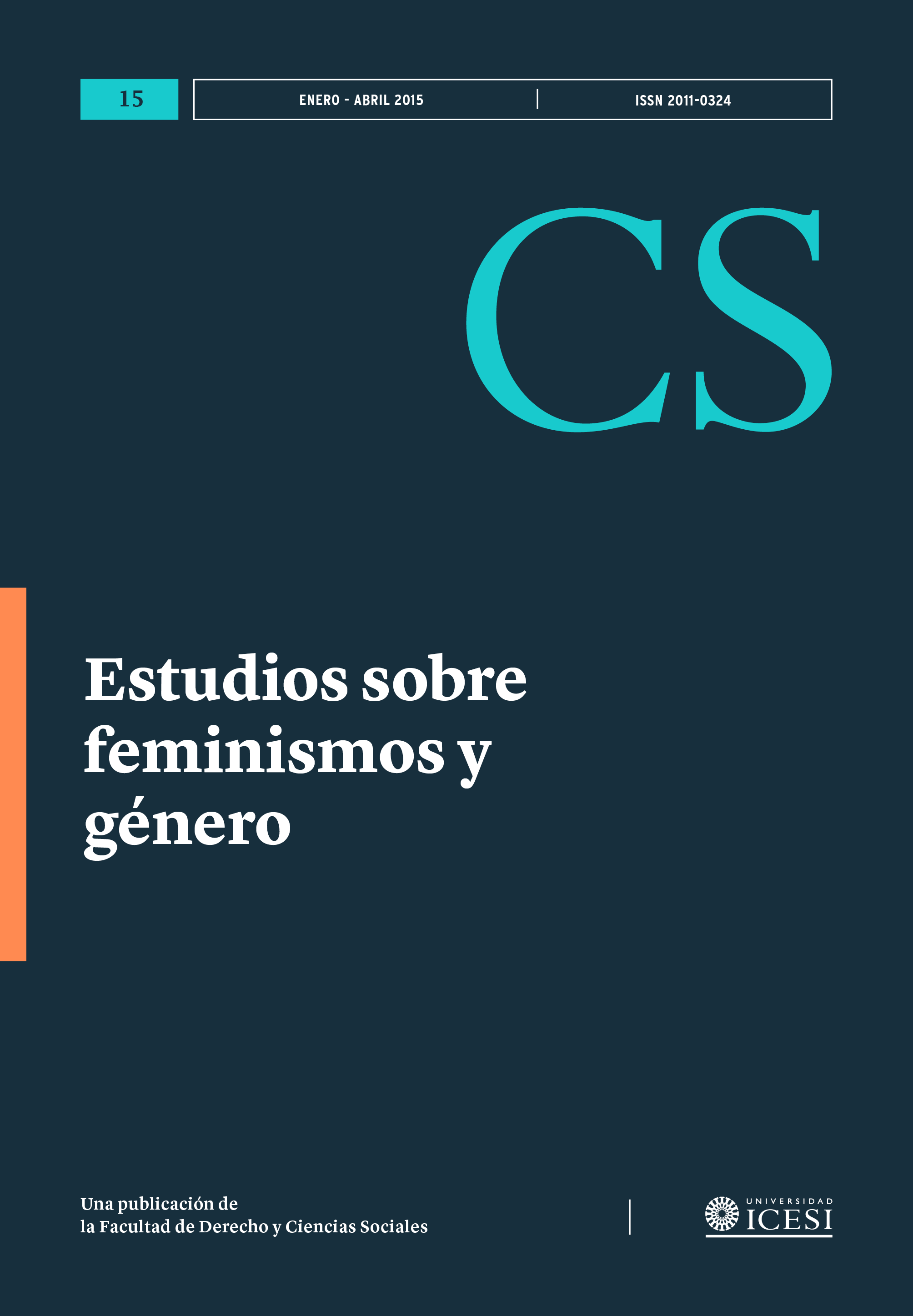Community Mothers: A paradigmatic case of how the law produces identities
DOI:
https://doi.org/10.18046/recs.i15.1910Keywords:
Community mothers, ICBF, gender, feminismAbstract
In 2012, because of judgment T-628 of that year, the 1607 Act was issued, whose Article 36 would radically change the status of community mothers in Colombia, as it regulates their employment status. The change came after many years of struggle. This article analyzes the legal status of community mothers in the years before the enactment of the law, from the perspective of gender, using various feminist positions. It aims to show how a public policy as the ICBF community homes, which featured a patriarchal and contingent world view, which locates women in work within the home, played an influential role in building the female identity, and perpetuated a system of specific domination.
Downloads
References
ALVIAR GARCÍA, H. (2008). Derecho, desarrollo y feminismo en América Latina. Bogotá: Universidad de los Andes.
ALVIAR, H. Y JARAMILLO, I. (2012). Feminismo y crítica jurídica. Bogotá: Siglo del hombre editores.
BENERÍA, L. (2006). Trabajo productivo/reproductivo, pobreza y políticas de conciliación. Nómadas, (24), 8– 21.
BERNAL, R., FERNÁNDEZ, C., FLÓREZ NIETO, C. E., GAVIRIA, A., OCAMPO, P. R., SAMPER, B., Y SÁNCHEZ, F. (2009). Evaluation of the early childhood program HogaresComunitariosde Bienestarin Colombia.Social ScienceResearch Network, http://dx.doi.org/10.2139/ssrn.1486209 (Recuperado el 3 de Abril de 2014).
BUCHELY, L. (2013). Activismo Burocrático. La construcción cotidiana del principio de legalidad. Tesis para optar al título de doctora en derecho. Bogotá: Universidad de los Andes.
COMITÉ PRO DESC DE LAS TRABAJADORAS COMUNITARIAS et al. (2003). ¿En qué vamos? Principales debates. Bogotá: Ediciones Ántropos.
CONSEJO DE ESTADO. Sala de lo contencioso administrativo. Sección segunda, subsección B.. Sentencia del 28 de Noviembre de 1996. Expediente 13023. C.P. Javier Díaz Bueno.
CONSEJO DE ESTADO. Sala de lo contencioso administrativo. Sección tercera, Subsección C.. Sentencia del 9 de mayo de 2011. Expediente: 050012331000200101546 02. C. P. Enrique Gil Botero.
CONSEJO DE ESTADO. Sala de lo contencioso administrativo. Sección Segunda, Subsección B. Sentencia del 9 de diciembre de 2012. Radicado número 11001–03–15–000–2010–01181–00(AC). C.P. Gerardo Arenas Monsalve.
CORTE CONSTITUCIONAL. Sentencia SU 224 de 1998. M.P. Hernando Herrera Vergara .
CORTE CONSTITUCIONAL. Sentencia T 269 de 1995. M.P. Jorge Arango Mejía.
CORTE CONSTITUCIONAL. Sentencia T 628 de 2012. M.P Humberto Sierra Porto.
DECRETO 1340 de 1995.
DECRETO 289 de 2014.
FLÓREZ, CARMEN ELISA. (1993). Hogares comunitarios de bienestar: Quién se beneficia. Informe final. Bogotá: Universidad de los Andes.
FOUCAULT, M. (1998). La verdad y sus formas jurídicas. Madrid: Editorial Gedisa.
FRASER, N. (2013). Fortunes of Feminism: From State–Managed Capitalism to Neoliberal Crisis. Verso.
FRASER, N. (1990). Struggle over needs: Outline of a socialist–feminist critical theory of late–capitalist political culture. Women, thestate, and welfare, 199–225.
FRUG, M. J. (2006). Comentario: Un manifiesto jurídico feminista posmoderno. En Crítica jurídica : teoría y sociología jurídica en los Estados Unidos. Bogotá: Universidad de los Andes.
GONZÁLEZ, G. YHERMANN, J. I.(1999). El rol de las madres comunitarias, su relación con la comunidad y con el ICBF. Trabajo de investigación profesoral. Bogotá: Universidad de los Andes.
HALLEY, J. (2008). Split decisions: How and why to take a break from feminism. Princeton UniversityPress.
HIRSCHMANN, N. J., Y LIEBERT, U. (2001). Women and welfare: Theory and practice in the United States and Europe. RutgersUniversityPress.
INSTITUTO COLOMBIANO DE BIENESTAR FAMILIAR (ICBF). (2011). Lineamiento técnico administrativo, modalidad Hogares Comunitarios de Bienestar en todas sus formas (familiares, grupales, múltiples, múltiples empresariales y jardines sociales) para la atención a niños y niñas hasta los cinco (5) años de edad. Dirección de prevención. Bogotá.
INSTITUTO COLOMBIANO DE BIENESTAR FAMILIAR (ICBF). (1997). Bogotá: Primera Encuesta Sistema de Evaluación de Impacto de Hogares Comunitarios de Bienestar. Bogotá.
JARAMILLO SIERRA, I. C. (2006). ''Reforma legal, feminismo y patriarcado en Colombia: El caso de la Ley de Cuotas para mujeres en cargos de alto nivel de la Rama Ejecutiva''. En Más allá del derecho. Bogotá: Siglo del Hombre Editores.
KENNEDY, DUNCAN. (1993). Sexy dressing, etc. Cambridge, Mass.: Harvard University Press.
LEY 89 de 1988.
OLSEN, F. (2000). El sexo del derecho. Identidad femenina y discurso jurídico. Buenos Aires: Ed. Biblos.
PERKINSGILMAN, C. (2008). Mujeres y Economía. Un estudio sobre la relación económica entre hombres y mujeres como factor de evolución social. Valencia: PUV Valencia.
PLATAFORMA COLOMBIANA DE DERECHOS HUMANOS, DEMOCRACIA Y DESARROLLO (2010). Informe alterno al quinto informe del estado colombiano ante el comité del pacto internacional de derechos económicos, sociales y culturales. Bogotá, http://www2.ohchr.org/english/bodies/cescr/docs/ngos/PCDHDD_Colombia_CESCR42.pdf (Bogotá, recuperado el 4 de abril de 2014)
Downloads
Published
Issue
Section
License
Copyright (c) 2015 Manuel Ricardo Pinzón

This work is licensed under a Creative Commons Attribution-NonCommercial 4.0 International License.
© Reserved Copyright
Material in this publication may be reproduced without authorization, provided the title, author and institutional source is acknowledged.
The content published in Revista CS is distributed under the Creative Commons BY-NC 4.0 Attribution/Recognition-NonCommercial 4.0 International license.
You are free to:
Share — copy and redistribute the material in any medium or format.
Adapt — remix, transform, and build upon the material.
Under the following terms:
Attribution — You must give appropriate credit , provide a link to the license, and indicate if changes were made . You may do so in any reasonable manner, but not in any way that suggests the licensor endorses you or your use.
NonCommercial — You may not use the material for commercial purposes.












